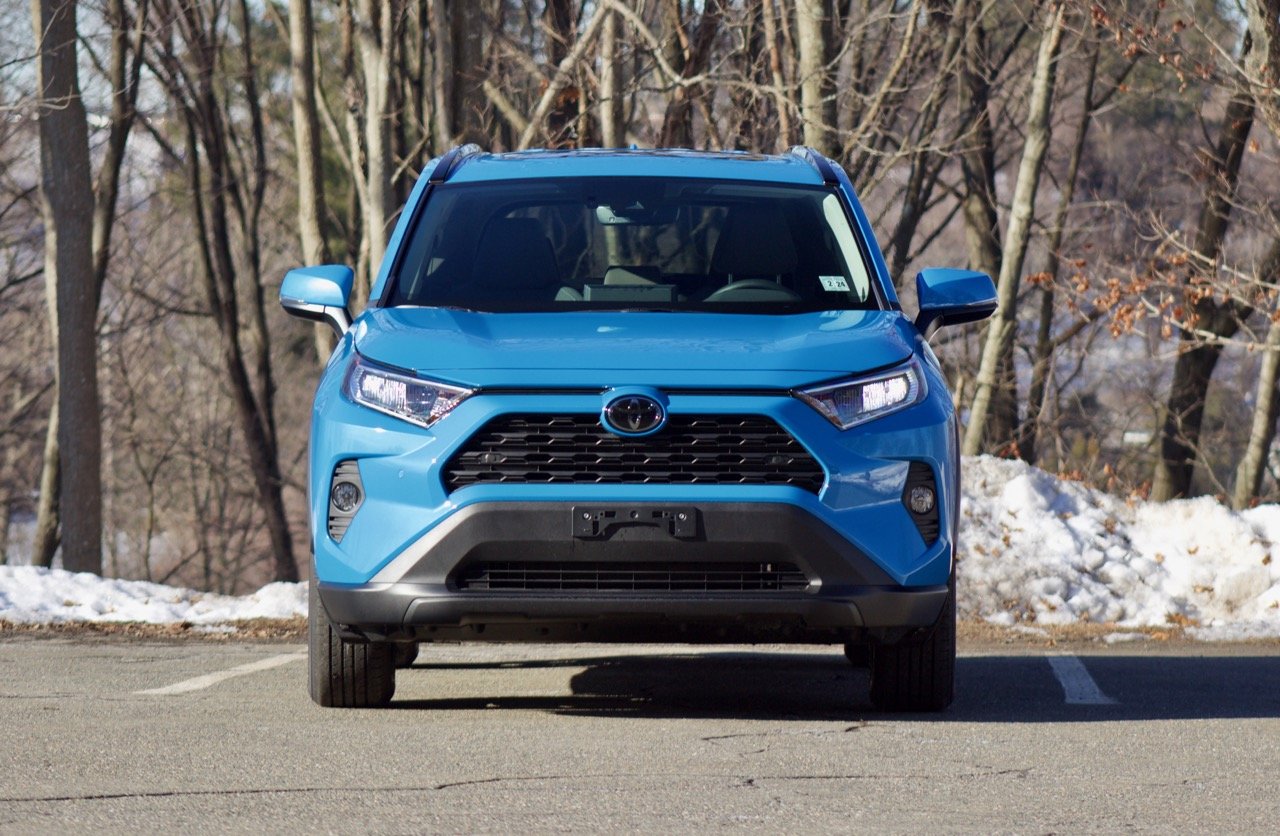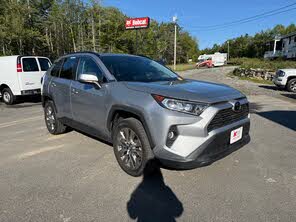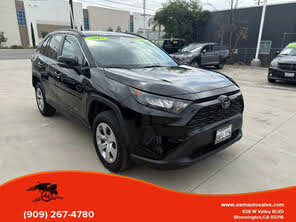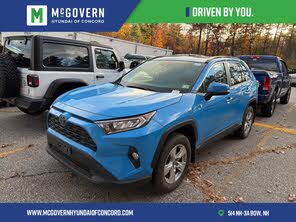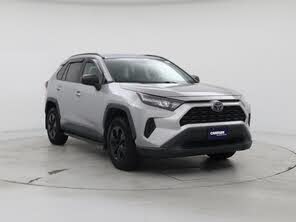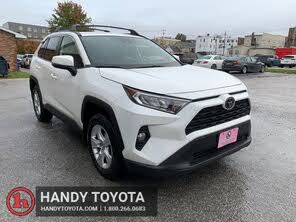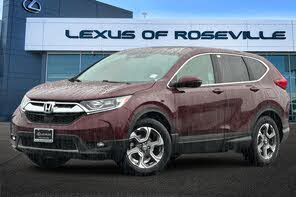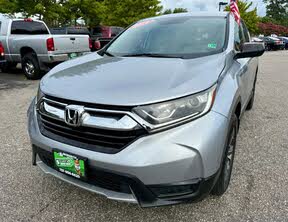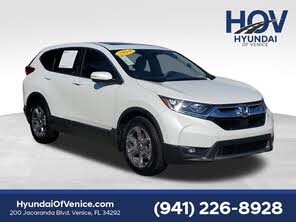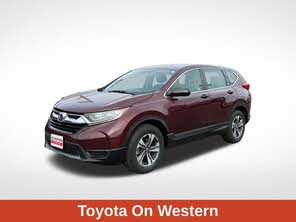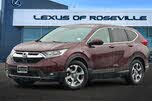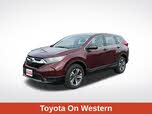2019 Toyota RAV4 vs 2019 Honda CR-V
Overview | |
MSRP$25,650 | MSRP$24,450 |
Listings1483 | Listings1793 |
Ratings & Reviews | |
User Reviews | User Reviews |
Expert reviews8.0 out of 10 | Expert reviews8.0 out of 10 |
Pros
Cons
| |
2019 Toyota RAV4 Reviews SummaryThere’s a reason small SUVs like the 2019 Toyota RAV4 are among the most popular vehicles on the new car market. Consider the RAV4 and its rivals, the Honda CR-V, Mazda CX-5, and Ford Escape—what do they have in common? To put it simply, these vehicles are asked to do it all. Daily commuter car? Check. Family-hauler to school, practice, and the mall? Check, check, and check. Road-trip vehicle? Yeah, that too. On top of it all, these vehicles have to be affordable, efficient, and reliable. Sales of traditional sedans have been dwindling, but if sedans could do as much as crossovers can, they would still be popular vehicles. The RAV4 is one of the oldest vehicles in the segment, and its story tells us how these small SUVs became so popular. The previous RAV4 was an extremely competent vehicle for Toyota, covering all the things we ask of compact SUVs. But the new 2020 RAV4 goes a few steps further. It has standout Tonka-truck styling, a surprisingly upscale interior, and something that it had lost since debuting more than two decades ago: a bit of off-road ability. We’ll see whether this makes it better than the RAV4 it replaces, and if it allows the 2020 RAV4 to stand out in a crowded small SUV market. | |
2019 Honda CR-V Reviews SummaryRefined, roomy, and historically reliable, the Honda CR-V has earned its status as one of the best selling vehicles in America. This is a safe SUV, too, and it returns good fuel economy while delivering lively performance. There are few reasons to cross the 2019 Honda CR-V off of your shopping list, and numerous reasons to drive one home from the dealership. | |
Popular Features & Specs | |
Engine2.5L 203 hp I4 | Engine2.4L 184 hp I4 |
Drive TrainFWD | Drive TrainFWD |
Seating Capacity5 | Seating Capacity5 |
Horsepower203 hp @ 6000 rpm | Horsepower184 hp @ 6400 rpm |
MPG City26 | MPG City26 |
MPG Highway35 | MPG Highway32 |
Engine | |
Engine Name2.5L 203 hp I4 | Engine Name2.4L 184 hp I4 |
Torque184 lb-ft @ 5000 rpm | Torque180 lb-ft @ 3900 rpm |
Horsepower203 hp @ 6000 rpm | Horsepower184 hp @ 6400 rpm |
DrivetrainFWD | DrivetrainFWD |
Fuel Economy | |
MPG City26 | MPG City26 |
MPG Highway35 | MPG Highway32 |
Interior | |
Seating Capacity5 | Seating Capacity5 |
Safety | |
Front Crash Overall4 | Front Crash Overall5 |
Side Crash Overall5 | Side Crash Overall5 |
Dimensions & Capacity | |
Cargo Space37.6 cu ft | Cargo Space39.2 cu ft |
Curb Weight3370 lbs | Curb Weight3307 lbs |
Height67.0 in | Height66.1 in |
Length180.9 in | Length180.6 in |
Width73.0 in | Width73.0 in |
Wheelbase105.9 in | Wheelbase104.7 in |
Maximum Payload1240 lbs | Maximum Payload1388 lbs |
Number of doors4 | Number of doors4 |
Maximum Towing Capacity1500 lbs | Maximum Towing Capacity1500 lbs |
Overview | ||
MSRP | $25,650 | $24,450 |
Listings | ||
Ratings & Reviews | ||
User reviews | ||
Expert reviews | 8.0 out of 10Read full review | 8.0 out of 10Read full review |
Pros & cons | Pros
Cons
| |
Summary | There’s a reason small SUVs like the 2019 Toyota RAV4 are among the most popular vehicles on the new car market. Consider the RAV4 and its rivals, the Honda CR-V, Mazda CX-5, and Ford Escape—what do they have in common? To put it simply, these vehicles are asked to do it all. Daily commuter car? Check. Family-hauler to school, practice, and the mall? Check, check, and check. Road-trip vehicle? Yeah, that too. On top of it all, these vehicles have to be affordable, efficient, and reliable. Sales of traditional sedans have been dwindling, but if sedans could do as much as crossovers can, they would still be popular vehicles. The RAV4 is one of the oldest vehicles in the segment, and its story tells us how these small SUVs became so popular. The previous RAV4 was an extremely competent vehicle for Toyota, covering all the things we ask of compact SUVs. But the new 2020 RAV4 goes a few steps further. It has standout Tonka-truck styling, a surprisingly upscale interior, and something that it had lost since debuting more than two decades ago: a bit of off-road ability. We’ll see whether this makes it better than the RAV4 it replaces, and if it allows the 2020 RAV4 to stand out in a crowded small SUV market. | Refined, roomy, and historically reliable, the Honda CR-V has earned its status as one of the best selling vehicles in America. This is a safe SUV, too, and it returns good fuel economy while delivering lively performance. There are few reasons to cross the 2019 Honda CR-V off of your shopping list, and numerous reasons to drive one home from the dealership. |
Video | ||
Popular Features & Specs | ||
Engine | 2.5L 203 hp I4 | 2.4L 184 hp I4 |
Drive Train | FWD | FWD |
Seating Capacity | 5 | 5 |
Horsepower | 203 hp @ 6000 rpm | 184 hp @ 6400 rpm |
MPG City | 26 | 26 |
MPG Highway | 35 | 32 |
Engine | ||
Engine Name | 2.5L 203 hp I4 | 2.4L 184 hp I4 |
Torque | 184 lb-ft @ 5000 rpm | 180 lb-ft @ 3900 rpm |
Horsepower | 203 hp @ 6000 rpm | 184 hp @ 6400 rpm |
Drivetrain | FWD | FWD |
Fuel Economy | ||
MPG City | 26 | 26 |
MPG Highway | 35 | 32 |
Interior | ||
Seating Capacity | 5 | 5 |
Safety | ||
Front Crash Overall | 4 | 5 |
Side Crash Overall | 5 | 5 |
Dimensions & Capacity | ||
Cargo Space | 37.6 cu ft | 39.2 cu ft |
Curb Weight | 3370 lbs | 3307 lbs |
Height | 67.0 in | 66.1 in |
Length | 180.9 in | 180.6 in |
Width | 73.0 in | 73.0 in |
Wheelbase | 105.9 in | 104.7 in |
Maximum Payload | 1240 lbs | 1388 lbs |
Number of doors | 4 | 4 |
Maximum Towing Capacity | 1500 lbs | 1500 lbs |
The 2019 Toyota RAV4 immediately grabbed attention with its bold and chunky design, heavily influenced by the Toyota Tacoma pickup. The sharp edges and aggressive styling gave it a futuristic and robust appearance. Along the side profile, this rugged design continued consistently, extending to the rear, where the taillights drew inspiration from Toyota's luxury brand, Lexus. It had a distinctive character line breaking up the rear C-pillar, a modern design trait, but not particularly visually appealing in the RAV4's application.
Color options for the RAV4 were intriguing as well. Around half matched the body to the roof, while seven options offered a contrasting-color roof—either gray or black. While the contrasting black strip across the rear pillar made sense for the two-tone options, it felt superfluous in the monotone schemes, adding unnecessary design clutter.
Inside, the RAV4’s chunky exterior gave way to a surprisingly simple and elegant cabin design. A floating touchscreen housed many features, while the rest of the controls were integrated into a "pod" spanning from the center of the dash to the cupholders.
The RAV4 came in multiple trims: LE, XLE, XLE Premium, Adventure, and Limited. The base LE featured steel 17-inch wheels with plastic covers, LED lighting, power side mirrors, and privacy-tinted windows. CarGurus recommended the XLE trim, which added 17-inch alloy wheels, automatic high beams, fog lights, color-keyed side mirrors with turn signals, a power moonroof, push-button start, sport bucket seats, and dual-zone climate control.
Stepping up to the XLE Premium trim offered 19-inch alloy wheels, a power rear liftgate, an 8-way power-adjustable driver’s seat, and SofTex leatherette upholstery. The rugged Adventure trim featured unique 19-inch wheels with matte accents, a unique front grille, black fender cladding, enhanced roof rails, and orange accented interior touches in a rugged direction. The Limited trim went for luxury with 19-inch chrome-finished alloy wheels, a distinctive grille, puddle approach lights, and premium interior features including dark brown accents, ambient lighting, and navigation.
In contrast, the 2019 Honda CR-V presented a smaller but refined exterior design. Available in four trims—LX, EX, EX-L, and Touring—all could be equipped with either FWD or AWD. The base model started at $24,350 and went up to $34,150. The CR-V LX featured standard 17-inch aluminum wheels, and higher trims added body-colored trim, larger 18-inch wheels, and rear privacy glass. The rear design of the CR-V was noted as upscale, while the front, described as a "Robot Horseshoe Crab" design, came across as less appealing.
Inside, the CR-V showcased quality materials and thoughtful construction. The 2-tone tan-over-black interior treatment provided a premium feel, and despite abundant hard plastic, it did not appear cheap. The layout and feel made it clear that the CR-V aimed to deliver value in terms of interior sophistication.


















The 2019 Toyota RAV4 came equipped with a 2.5-liter 4-cylinder engine producing 203 horsepower and 184 pound-feet of torque, paired with an 8-speed automatic transmission. Available in either FWD or AWD, it featured two AWD flavors: a base offering and a new torque-vectoring AWD found on the Adventure and Limited trims. The XLE test model had the base AWD, including Snow, Sand & Mud, and Rock & Dirt drive modes to boost its rugged appeal.
Though the 2.5-liter engine delivered decent highway performance, it struggled with low-end power, resulting in sluggish acceleration from a standstill and a lot of engine noise. The ride quality was comfortable with good bump absorption, but issues like twitchy steering and significant body roll affected driving dynamics, especially through fast corners. Fuel economy was commendable, with the AWD model returning 27 mpg city and 34 mpg highway, and an observed 29.3 mpg combined during a week of testing.
Meanwhile, the 2019 Honda CR-V offered two engine options. The base CR-V LX featured a 2.4-liter 4-cylinder engine producing 184 horsepower and 180 pound-feet of torque, paired with a CVT. The EX, EX-L, and Touring trims came with a turbocharged 1.5-liter 4-cylinder engine delivering 190 horsepower and 179 pound-feet of torque, also paired with a CVT.
The turbocharged engine was more responsive with satisfying acceleration and better fuel economy, though it had issues in cold weather and short trips, potentially leading to fuel mixing with engine oil. Some CR-V owners also reported battery problems, with Honda investigating the cause.
Driving dynamics for the CR-V were impressive, partly due to a MacPherson strut front and multi-link double-wishbone rear suspension. Steering was dynamic, light and effortless at lower speeds but providing heft at higher speeds. The SUV also featured Straight Driving Assist, reducing driver fatigue on crowned roads. Braking was excellent, with reliable pedal feel and modulation, even during mountain drives with a full load.
The 2019 Toyota RAV4 boasted a clean and upscale interior with practical touches, including spacious seating and ample cargo space. The center stack pod organized climate controls, a large tray for small items, drive-mode controls, and a short shifter. The interior also featured a deep center console bin and extra trays for convenient storage.
With the rear seats up, the RAV4 offered 37.6 cubic feet of cargo space, expanding to 69.8 cubic feet with the seats down. Despite a reduction from 2018, this was still competitive in the segment, though the Honda CR-V and Subaru Forester offered more, each with around 75 cubic feet.
The CR-V's interior was spacious and family-friendly, but it lacked an adjustable height passenger seat, a significant drawback for many. The driver’s seat was highly adjustable and comfortable, especially in trims above the base LX. Heated front seats were standard on all but the LX, with a heated steering wheel available as an option.
Rear seating provided ample space for kids and adults alike, along with useful air vents and USB ports in higher trims. The CR-V also excelled in storage space, with a large glove box, a sizable center console bin, and generous cargo capacity. It offered 39.2 cubic feet of space behind the rear seats, expandable to 75.8 cubic feet with the seats folded, beating the RAV4.
The 2019 Toyota RAV4’s LE trim featured a 7-inch touchscreen with Apple CarPlay but lacked Android Auto. Other tech included Bluetooth connectivity, a USB port, and a WiFi hotspot. The XLE added more USB ports and equipment, while the Adventure trim received an upgraded reversing camera, a 7-inch instrument panel display, and an 8-inch infotainment screen. The Limited trim offered optional features like a JBL premium stereo.
Toyota's new infotainment system was easy to use, featuring hard dials for major functions and real dials for volume and tuning. The big update was the inclusion of Apple CarPlay, though Android Auto was still missing.
The 2019 Honda CR-V, starting from the EX trim, came equipped with lots of infotainment and driver-assistance features. The LX had basic Bluetooth connectivity, while higher trims included a 7-inch touchscreen, Apple CarPlay, Android Auto, SiriusXM, text messaging capability, and HondaLink connected services. Navigation was optional on the EX-L and standard on Touring. The Touring model also featured a premium sound system.
Honda had been improving its infotainment systems, but the one in the CR-V still lacked a tuning knob and had a relatively small 7-inch screen. The system was somewhat distracting due to specific voice activation prompts and occasional failures requiring a restart.
The 2019 Toyota RAV4 featured a comprehensive suite of standard safety features, including a full array of airbags, a reversing camera, traction control, and a tire-pressure monitoring system. Toyota Safety Sense 2.0 was standard, incorporating forward-collision warning, lane-departure warning, automatic high-beams, dynamic radar cruise control, traffic-sign detection, and Lane-Tracing Assist.
The 2019 Honda CR-V equipped nearly all trim levels with Honda Sensing, a suite of advanced safety features including adaptive cruise control, forward-collision warning with automatic emergency braking, lane-departure warning, lane-keeping assist, and a road-departure mitigation system. Higher trims added a blind-spot-monitoring system with rear cross-traffic alert. The Safety systems worked well but lacked some refinement. The lane-keeping assist system allowed the car to wander, and the adaptive cruise control made noticeable brake inputs.
The CR-V also featured a standard multi-angle reversing camera and earned a Top Safety Pick from the IIHS, falling just short of Top Safety Pick Plus due to headlight performance.
CarGurus highlights
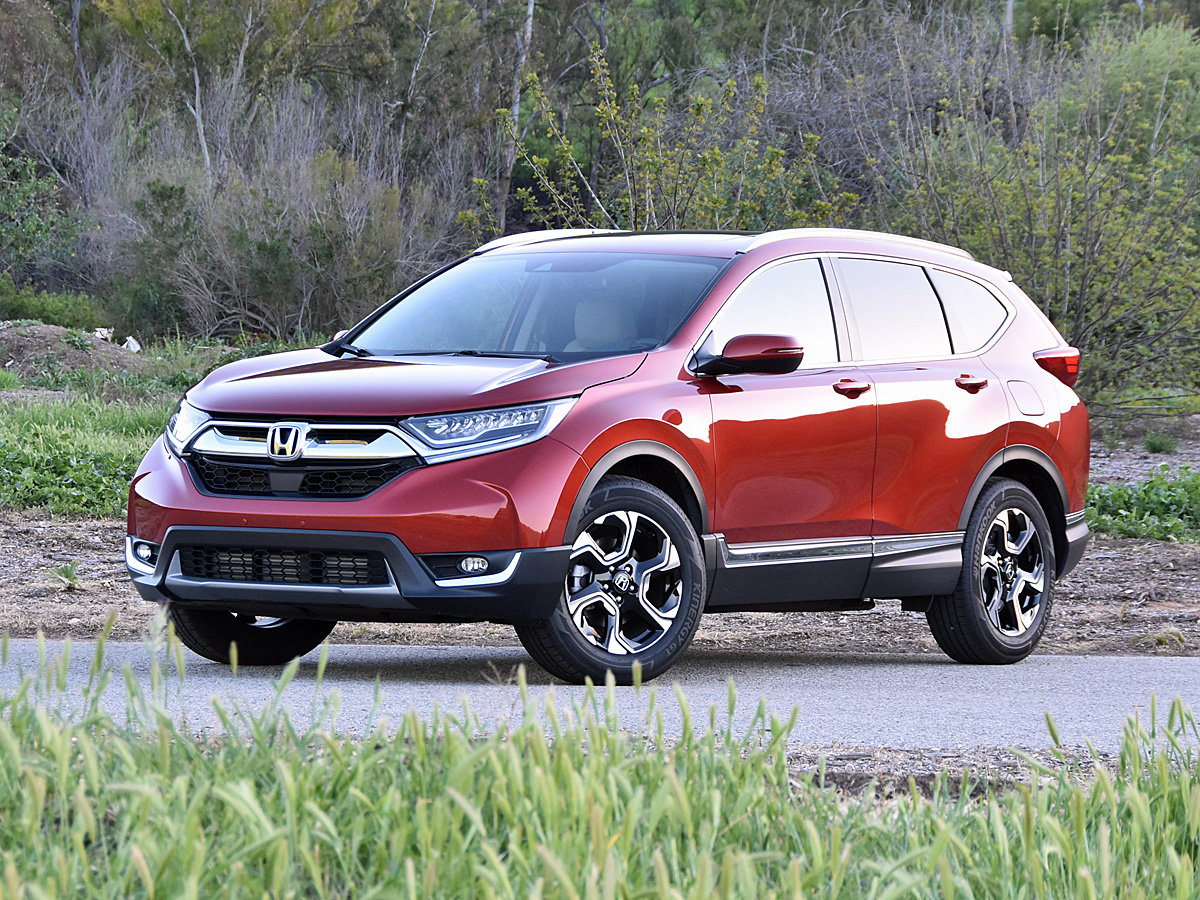
According to CarGurus experts, the overall rating for the 2019 Toyota RAV4 is 8.1 out of 10, while the 2019 Honda CR-V scores 8.5 out of 10. While both vehicles offer strong performance, ample features, and safety equipment, the Honda CR-V ultimately gets the higher rating due to its superior cargo space, more advanced powertrain options, more refined safety technology, and overall value. Therefore, based on these ratings, the final recommendation leans towards the Honda CR-V as the better choice for discerning buyers.
Choose the 2019 Toyota RAV4 if:
- You value robust, off-road capabilities combined with a comfortable ride.
- You prefer a user-friendly infotainment system with Apple CarPlay.
- You seek a vehicle with a rugged and aggressive design aesthetic.
Choose the 2019 Honda CR-V if:
- You require more cargo space and interior storage options for family needs.
- You want a vehicle equipped with a turbocharged engine that delivers better acceleration and fuel economy.
- You need advanced safety features and driver-assistance technology standard on most trims.
CarGurus highlights

According to CarGurus experts, the overall rating for the 2019 Toyota RAV4 is 8.1 out of 10, while the 2019 Honda CR-V scores 8.5 out of 10. While both vehicles offer strong performance, ample features, and safety equipment, the Honda CR-V ultimately gets the higher rating due to its superior cargo space, more advanced powertrain options, more refined safety technology, and overall value. Therefore, based on these ratings, the final recommendation leans towards the Honda CR-V as the better choice for discerning buyers.
Choose the 2019 Toyota RAV4 if:
Shop Now- You value robust, off-road capabilities combined with a comfortable ride.
- You prefer a user-friendly infotainment system with Apple CarPlay.
- You seek a vehicle with a rugged and aggressive design aesthetic.
Choose the 2019 Honda CR-V if:
Shop Now- You require more cargo space and interior storage options for family needs.
- You want a vehicle equipped with a turbocharged engine that delivers better acceleration and fuel economy.
- You need advanced safety features and driver-assistance technology standard on most trims.

By: CarGurus + AI
At CarGurus, our team of experienced automotive writers remain at the heart of our content operation, conducting hands-on car tests and writing insightful guides that are backed by years of industry experience. To complement this, we are harnessing AI to make our content offering more diverse and more helpful to shoppers than ever. To achieve this, our AI systems are based exclusively on CarGurus content, ratings and data, so that what we produce is both unique to CarGurus, and uniquely helpful to car shoppers.
